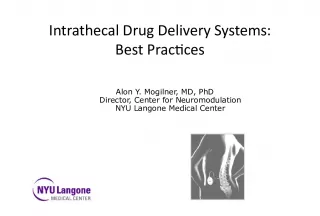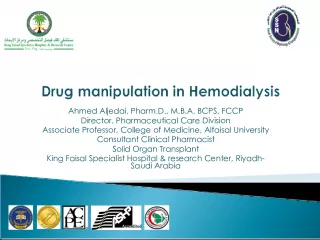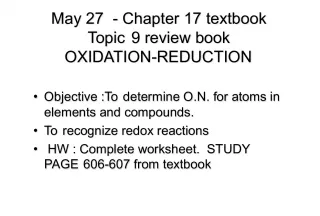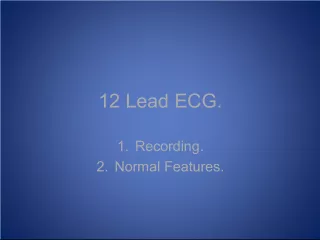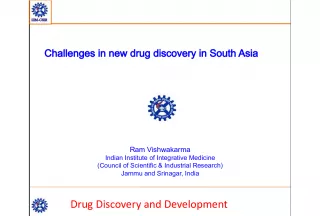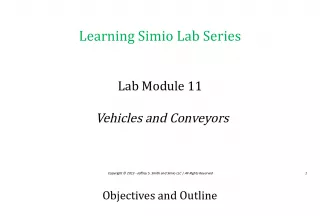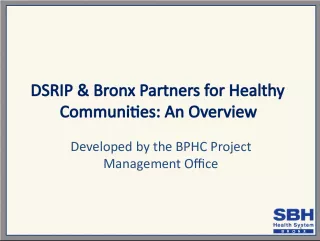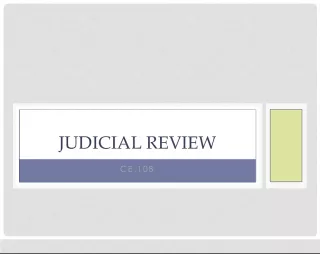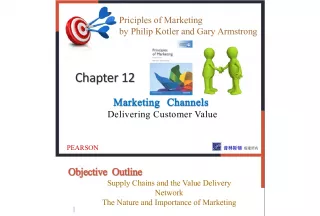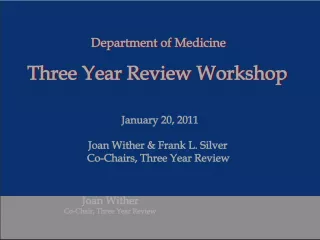Niosomes as Drug Delivery Vehicles: A Comprehensive Review
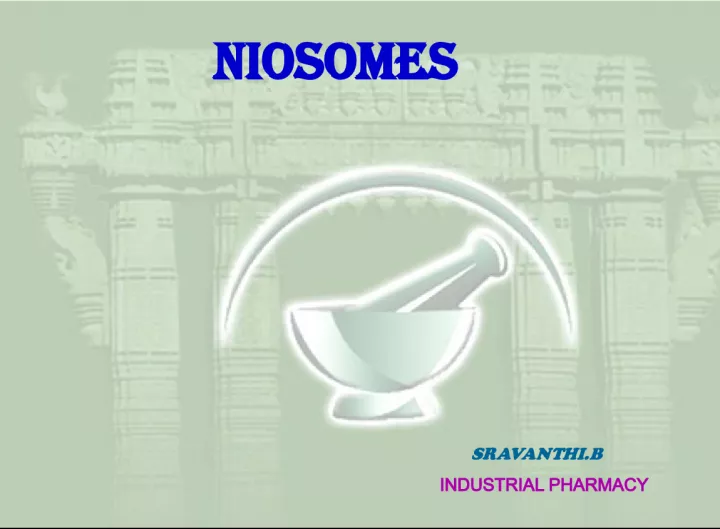

This article discusses the definition, structure, preparation methods, advantages, disadvantages, drug loading, characterization, applications, recent advances, and stability of niosomes as drug delivery vehicles.
- Uploaded on | 2 Views
-
 nakisha
nakisha
About Niosomes as Drug Delivery Vehicles: A Comprehensive Review
PowerPoint presentation about 'Niosomes as Drug Delivery Vehicles: A Comprehensive Review'. This presentation describes the topic on This article discusses the definition, structure, preparation methods, advantages, disadvantages, drug loading, characterization, applications, recent advances, and stability of niosomes as drug delivery vehicles.. The key topics included in this slideshow are Niosomes, drug delivery, non-ionic surfactants, bilayers, encapsulation,. Download this presentation absolutely free.
Presentation Transcript
1. NIOSOMeS SRAVANTHI.B INDUSTRIAL PHARMACY
2. Contents Introduction Structure of niosomes Materials used in the preparation of niosomes Advantages & disadvantages of niosomes Formation of niosomes from proniosomes Methods of preparation Size reduction methods & drug loading Encapsulation of drugs & removal of unentrapped drug Characterization of niosomes Stability of niosomes Applications Recent advances in niosomes Conclusion References
3. INTRODUCTION Niosomes definition Niosomes are essentially non-ionic surfactant based multilamellar or unilamellar vesicles in which an aqueous solution of solute (s) is entirely enclosed by a membrane resulted from the organization of surfactant macromolecules as bilayers Niosomes made-up of self assembly of hydrated nonionic surfactant molecules (eg: tweens and spans) with or with out cholesterol and dicetyl phosphate . The assembly into closed bilayers is rarely spontaneous and usually involves some input of energy such as physical agitation or heat.
4. Niosomes also called as Nonionic surfactant vesicles or NSV s Nios = non ionic surfactant somes = vesicles NSV S results from the self assembly of hydrated surfactant monomers results in closed bilayer structures Drug carriers Biodegradable, biocompatible and non immunogenic Large qty of material can be encapsulated Very small ,microscopic in size. Most surface active agents when immersed in water yield micellar structures, how ever some surfactants can yield bilayered vesicles which are niosomes
5. STRUCTURE OF NIOSOMES
6. COMPARISION OF NIOSOMES V S LIPOSOMES Niosomes behave in-vivo like liposomes, prolonging the circulation of entrapped drug And altering its organ distribution and metabolic stability In both basic unit of assembly is Amphiphiles, but they phospholipids in liposomes and nonionic surfactants in niosomes . Both can entrap hydrophilic and lipophilic drugs. Both have same physical properties but differ in their chemical composition . Niosomes has higher chemical stability than liposomes. Niosomes made of uncharged single chain surfactant molecules Liposomes made of neutral or charged double chain phospholipids . Niosomes and liposomes are similar in- Function Increase the bioavailability Decrease the clearence Used for targeted drug delivery Properties depends on both composition of bilayer and method of preparation
7. ADVANTAGES OF NIOSOMES OVER LIPOSOMES Ester bonds of phospholipids are easily hydrolyzed, this can lead to phosphoryl migration at low P H Peroxidation of unsaturated phospholipids. This requires that purified phospholipids and liposomes have to be stored and handled in an inert (N 2 ) atmosphere this problem is not seen with niosomes because these are made up of nonionic surfactants & these does require special storage condition Phospholipid raw materials are naturally occurring substances and as such require extensive purification thus making them costly Niosomes has high adjuvanticity when compared to liposomes
8. ADVANTAGES OF NIOSOMES They are osmotically active and stable. They increase the stability of the entrapped drug Handling and storage of surfactants do not require any special conditions Can increase the oral bioavailability of drugs Can enhance the skin penetration of drugs They can be used for oral, parenteral as well topical use In cosmetics was first done by LOreal as they offered the following advantages: The vesicle suspension being water based offers greater patient compliance over oil based systems Since the structure of the niosome offers place to accommodate hydrophilic, lipophilic as well as amphiphilic drug moieties, they can be used for a variety of drugs. The characteristics such as size, lamellarity etc. of the vesicle can be varied depending on the requirement . The vesicles can act as a depot to release the drug slowly and offer a controlled release .
9. The surfactants are biodegradable, biocompatible, and non-immunogenic Improve the therapeutic performance of the drug by protecting it from the biological environment and restricting effects to target cells, thereby reducing the clearance of the drug. The Niosomal dispersions in an aqueous phase can be emulsified in a non-aqueous phase to control the release rate of the drug and administer normal vesicles in external non-aqueous phase. USES OF NIOSOMES Topical niosomes may serve as - As solubilization matrix, As a local depot for sustained release of dermally active compounds, As penetration enhancers, As rate-limiting membrane barrier for the modulation of systemic absorption of drugs
10. DISADVANTAGES/PROBLEMS ASSOCIATED WITH NIOSOMES As high input of energy is required in the size reduction of niosomes, they aggregate and fuse togeather on prolonged storage Physicochemical instability remains the major problem in the development of Niosomal system at industrial levels DISTRIBUTION OF DRUGS IN NIOSOMES Carriers for both lipophilic & hydrophilic drugs Highly hydrophilic drugs are exclusively located in the aqueous domain Highly lipophilic drugs are entrapped within the lipid bilayers of the niosomes Drugs with intermediary partition coefficient equilibrate b/w lipid & aqueous domains
11. Different Niosomes 1. Bola-Surfactant containing Niosomes : Niosomes made of alpha,omega-hexadecyl-bis-(1-aza-18-crown-6) (Bola-surfactant)-Span 80-cholesterol (2:3:1 molar ratio) are named as Bola-Surfactant containing Niosomes. 2. Proniosomes : A dry product which may be hydrated immediately before use to yield aqueous Niosome dispersions. These proniosomes minimize problems of Niosome physical stability such as aggregation, fusion and leaking, and provide additional convenience in transportation, distribution, storage, and dosing. In short; 1. Carrier + Surfactants = Proniosomes 2. Proniosomes + H2O = Niosomes In case of Frusemide delivery in the body, it has been found that proniosomal formulations have been found effective
12. MOLECULAR GEOMETRY & VESICLE FORMATION Concept of Critical Packing Parameter (Israelachvili, 1985) Prediction of vesicle forming ability is not a simply a matter of HLB CPP = v /lca0 where v - hydrophobic group volume, lc - critical hydrophobic group length and a0 - area of the hydrophilic head group CPP between 0.5 and 1 likely to form vesicles. <0.5 (indicating a large contribution from the hydrophilic head group area) is said to give spherical micelles. >1 (indicating a large contribution from the hydrophobic group volume) should produce inverted micelles, the latter presumably only in an oil phase, or precipitation would occur.
13. Small Unilamellar Vesicle (SUV) Large Unilamellar Vesicle (LUV) Multilamellar Vesicle (MLV) Typical Size Ranges: SLV: 20-50 nm MLV:100-1000 nm
14. MATERIALS USED IN THE PREPARATION OF NIOSOMES Non ionic surfactants Amphiphiles Sterols like cholesterol Charge inducers Non-ionic surfactant structure Hydrophilic head groups found in vesicle forming surfactants Glycerol head groups Ethylene oxide head groups Crown ether head groups Polyhydroxy head groups Sugar head groups + amino acids Sugar head groups (galactose, mannose, glucose, lactose) Hydrophobic moiety One or two alkyl or perfluoroalkyl groups or in certain cases a single steroidal group. Alkyl group chain length is usually from C12C18 (one, two or three alkyl chains.
15. Perfluoroalkyl surfactants that form vesicles possess chain lengths as short as C10 Additionally crown ether amphiphiles bearing a steroidal C14 alkyl or C16 alkyl hydrophobic unit have been shown to form vesicles. The water soluble detergent polysorbate 20 also forms niosomes in the presence of cholesterol two portions of the molecule are linked by ether, ester & amide linkages. . STEROIDS Cholesterol Improves the fluidity of the bilayer. Minimizes leaching out of water soluble drug. Systems resulting in less leaky vesicles. Improves stability in biological fluids reduce interaction with plasma proteins CHARGE INDUCERS Dicetyl Phosphate, Sod. Cholate, Stearylamine Prevents aggregation Increases drug loading of water soluble drugs in MLV
16. FACTORS GOVERNING THE SELF ASSEMBLY OF NIOSOMES Non ionic surfactant structure Membrane additives Nature of the encapsulated material/drug Surfactant & lipid levels Temperature of hydration
17. FACTORS INFLUENCING THE NIOSOMAL PHYSICAL CHEMISTRY
18. Formation of niosomes from proniosomes Another method of producing niosomes is to coat a water-soluble carrier such as sorbitol with surfactant. The result of the coating process is a dry formulation. In which each water- soluble particle is covered with a thin film of dry surfactant. This preparation is termed Proniosomes. The niosomes are recognized by the addition of aqueous phase at T > Tm and brief agitation. T = Temperature. Tm = mean phase transition temperature.
19. Method of preparation A. Ether injection method surfactant : cholesterol(150 mol ) ether(20ml) 14 gauge needle (.25ml/min) aqueous phase (4ml at 60 0 c) Mechanism of action: Slow vapourization of solvent resulting into a ether gradient extending across the interfacial lipid/surfactant monolayer at ether water interface results in the formation of bilayer sheet which eventually folds on itself to form sealed vesicles. B. HAND SHAKING METHOD (THIN FILM TECNIQUE) Surfactant : cholesterol(150 mol ) diethyl ether(10ml) evaporated in rotary evaporater Surfactant swells Folds to form vesicles hydration LUV
20. C. SONICATION surfactant : cholesterol (150mol) Aqueous phase in vial (2ml ) Probe sonication (3min at 60 0 c) MLV Ultrasonic vibration ULV D. REVERSE PHASE EVAPORATION Probe sonicator used when sample size is small volume Bath sonicator used for larger volumes surfactant Chloroform& phosphate buffer W/O emulsion Sonication & evaporation vesicles hydration
21. E . MICROFLUIDIZATION This method is based on submerged jet principle in which two fluidized streams interact at ultra high velocities, in precisely defined micro channels within the interaction chamber . The impingement of thin liquid sheet along a common front is arranged such that the energy supplied to the system remains within the area of niosomes formation. The result is a greater uniformity, smaller size and better reproducibility of niosomes formed METHODS USED FOR NIOSOME PREPARATION IN INDUSTRIAL SCALE ARE Novasome Handjani Vila et al. - for larger qty i.e. Kg of dispersions
22. F. Multiple membrane extrusion method Surf actant, cholesterol, diacetyl phosphate in chloroform Thin films by evaporation Hydrated with aqc drug soln Suspension extruded through polycarbonate membranes Upto 8 passages forms vesicles G. Trans membrane pH gradient (inside acidic) Drug Uptake Process (Remote Loading) Surfactant, cholesterol in chloroform evaporation Hydration with 300mM citric acid MLV Frozen,thawed & sonicated (Niosomal suspension) Acq drug soln (10mg/ml) P H 7 -7.2 with 1M disodium phosphate Heating at 60 0 c forms niosomes Niosomes (of controlled size)
23. H. BUBBLE METHOD This method does uses organic solvents - adv The bubbling unit consists of round-bottomed flask with three necks positioned in water bath to control the temperature. Water-cooled reflux and thermometer is positioned in the first and second neck and nitrogen supply through the third neck Surfactant, cholesterol Dissolved in buffer at p H 7.4 at 70 0 c Homogenization For 15 min Bubbled at 70 0 c using N 2 gas niosomes I. MICELLAR SOLUTION METHODS Mixed micellar solution Esterases ,non ionic surfactant , NIOSOMES Charged inducer Esterases enzymes cleavage the micellar solution
24. SIZE REDUCTION METHODS Probe sonication 100 -140nm Extrusion method in the range of 140nm Sonication & filtration in the range of 200nm Microfluidizer < 50nm High pressure homogenization <100nm DRUG LOADING Active loading / Remote loading Passive loading
25. ENCAPSULATION OF DRUGS IN NIOSOMES Encapsulation volume/Trapped volume Volume of aqueous solution entrapped in niosomes per mole of surfactant (L/mol surfactant) Encapsulation Efficiency It is determined after separation of unentrapped drug, on complete vesicle disruption by using about 1 ml of 2.5% sodium lauryl sulphate, briefly homogenized and centrifuged and supernatant assayed for drug after suitable dilution. % Encapsulation Drug entrapped in niosomes x 100 Total drug added
26. The effect of the choice of niosome forming surfactant on the properties of the niosome dispersion
27. The effect of the nature of the encapsulated drug on the properties of the niosome dispersion.
29. Method of preparation Drug incorporated Ether Injection Sodium stibogluconate Doxorubicin Hand Shaking Methotrexate Doxorubicin Sonication Reverse phase evaporation 9-desglycinamide 8-arginine Vasopressin Oestradiol Diclofenac sodium DRUGS INCORPORATED INTO NIOSOMES BY VARIOUS METHODS
30. . Characterization of niosomes a) Entrapment efficiency The drug remained entrapped in niosomes is determined by complete vesicle disruption using 50% n- propanol or 0.1% Triton X-100 and analyzing the resultant solution by appropriate assay method for the drug. Where, Entrapment efficiency (EF) = ( amount entrapped / total amount) x 100 b) Vesicle diameter Niosomes, similar to liposomes, assume spherical shape and so their diameter can be determined using light microscopy, photon correlation microscopy freeze fracture electron microscopy. Freeze thawing (keeping vesicles suspension at 20C for 24 hrs and then heating to ambient temperature) of niosomes increases the vesicle diameter, which might be attributed to fusion of vesicles during the cycle
31. ( c) In-vitro release dialysis tubing A dialysis sac is washed and soaked in distilled water. The vesicle suspension is pipetted into a bag made up of the tubing and sealed. The bag containing the vesicles is placed in 200 ml of buffer solution in a 250 ml beaker with constant shaking at 25C or 37C. At various time intervals, the buffer is analyzed for the drug content by an appropriate assay method Factors affecting vesicles size, entrapment efficiency and release characteristics a) Drug entrapment of drugs in niosomes increase the vesicle size by- 1.interaction of solute with surfactant head groups 2.increasing the charge 3.mutual repulsions of the surfactant bilayers In PEG coated vesicles, some of the drug entrapped in long PEG chains there by reducing the charge
32. b) Amount and type of surfactant Hydrophilic Lipophilic Balance (HLB) is a good indicator of the vesicle forming ability of any surfactant. With the sorbitan monostearate (Span) surfactants, a HLB number of between 4 and 8 was found to be compatible with vesicle formation Bilayers of vesicles are in gel or liquid state depending on- 1. Temp 2. Type of liquid or surfactant 3. Cholesterol Surfactants or lipids are characterized by gel - liquid phase transition temp (TC) TC of surfactant also effect entrapment efficiency i.e., span 60 has higher TC so better entrapment c) cholesterol content & charge Cholesterol increase the hydrodynamic diameter & entrapment efficiency
33. Action is two ways 1. Increase the chain order of liquid state bilayers 2. Decrease the chain order of gel state bilayers at high cholesterol conc - gel state less ordered liquid crystalline phase Increase in cholesterol content- Increase the rigidity of bilayers Decrease the release rate of encapsulated material charge - induced by stearylamine & Diacetyl phosphate Increase the interlamellar distance b/w the successive bilayers in multilamellar vesicles Overall greater entrapped volume
34. d) Methods of preparation Hand shaking method forms vesicles with greater diameter (0.35-13nm) compared to the ether injection method (50-1000nm) Small sized niosomes can be produced by Reverse Phase Evaporation (REV) method Micro fluidization method gives greater uniformity and small size vesicles. Niosomes also prepared by trans membrane pH gradient (inside acidic) drug uptake process , showed greater entrapment efficiency and better retention of drug e) Resistance to osmotic stress Addition of a hypertonic salt solution to a suspension of niosomes brings about reduction in diameter. In hypotonic salt solution, there is initial slow release with slight swelling of vesicles probably due to inhibition of eluting fluid from vesicles, followed by faster release, which may be due to mechanical loosening of vesicles structure under osmotic stress.
35. CHARACTERIZATION OF NIOSOMES Mean Size & Size distribution - Electron Microscopy Dynamic Light Scattering (PCS) molecular sieve chromatography Surface Potential & Surface pH - Micro electrophoresis No of lamellae - Small angle X ray Scattering, NMR, Electron microscopy Structural & Motional behavior of lipids - DSC, ESR, NMR Surface Chemical Analysis - NMR Bilayer formation - X cross formation under light polarization microscopy Membrane rigidity - mobility of fluorescence probe as a function of temp
36. STABILITY OF NIOSOMES Stability in buffer Stability in hypertonic media Stability in hypotonic media Stability in vivo Stability is also influenced by Surfactant/lipid ratio Encapsulated drug Temperature of storage Detergents
37. Applications 1) Targeting of bioactive agents a) To reticulo - endothelial system (RES) b) To organs other than RES 2) Neoplasia Doxorubicin dose dependant irreversible cardio toxic effect. Niosomal delivery of this drug to mice bearing S-180 tumor increased their life span and decreased the rate of proliferation of sarcoma. Niosomal entrapment increased the half-life of the drug, prolonged its circulation and altered its metabolism. Intravenous administration of methotrexate entrapped in niosomes to S-180 tumor bearing mice resulted in total regression of tumor and also higher plasma level and slower elimination.
38. 3) Leishmaniasis sodium stibogluconate 4) Niosomes in Oral & Opthalmic drug delivery Oral - Ergot alkaloids Opthalmic - Cyclopentolate (polysorbate 20 & cholesterol) 5) Diagnostic imaging with niosomes Iopromide 6) Anti infective agents Rifampicin 7) Anti cancer therapy methotrexate 8) Niosomes as Vaccine Adjuvants 9) Delivery of peptide drugs 9-desglycinamide, 8-arginine, vasopressin
39. 10) Immunological application 11) Carriers for haemoglobin 12) Transdermal delivery of drugs Oestradiol 13) Other applecations a) Sustained release b) Localized drug action c) Cosmetics 14) Niosomes also used as drug carrier Ciprofloxacin & Norfloxacin Doxorubicin Indomethacin Pentoxyphillin Diclofenac Sodium 9 desglycinamide 8 Arginine Vasopressin Propylthiouracil
40. Suitable niosome sizes for particular routes of administration
41. RECENT ADVANCES IN NIOSOMES Combination of PEG and glucose conjugates on the surface of niosomes significantly improved tumor targeting of an encapsulated paramagnetic agent assessed with MR imaging in a human carcinoma xenograft model. Phase I and phase II studies were conducted for Niosomal methotrexate gel in the treatment of localized psoriasis. These studies suggest that niosomal methotrexate gel is more efficacious than placebo and marketed methotrexate gel. A research article was published that Acyclovir entrapped niosomes were prepared by Hand shaking and Ether injection methods increases the oral bioavailability Lancome has come out with a variety of anti-ageing products which are based on niosome formulations
42. Conclusion The concept of incorporating the drug into liposomes or niosomes for a better targeting of the drug at appropriate tissue destination is widely accepted by researchers and academicians. Niosomes represent a promising drug delivery module. They presents a structure similar to liposome and hence they can represent alternative vesicular systems with respect to liposomes, due to the niosome ability to encapsulate different type of drugs within their multi environmental structure. Niosomes are thoughts to be better candidates drug delivery as compared to liposomes due to various factors like cost, stability etc . Various type of drug deliveries can be possible using niosomes like targeting, ophthalmic, topical, parenteral, etc. Niosomes can also serve better aid in diagnostic imaging and vaccine adjuvant in pharmaceutical industry. Niosomes are considered as promising controlled drug delivery carrier which increase the half life of drugs and helps in formulating prolonged/controlled acting dosage forms Niosomes have great drug delivery potential for targeted delivery of anti-cancer, anti infective agents.
43. REFERENCES 1) S.P.Vyas, R.K.Khar., Targetted and controlled drug delivery. 2) N.K.Jain., Advances in controlled and novel drug delivery. 3)James Swarbrick, Encyclopedia of pharmaceutical technology, third edition , vol-2 4) en.wikipedia.org 5) Informa Healthcare Journal of Liposome Research 6) AAPS PharmaSciTec.com 7) Pharmainfo.net 8) I. F. Uchegbu, S.P. Vyas : International Journal of Pharmaceutics 172 (1998) 3370 9)Journal of Pharmacy Research Vol.1.Issue 2. Oct-December 2008
44. ?
